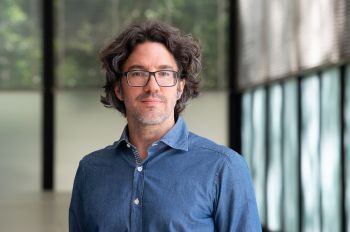How Design Is Demystifying Cancer Treatment
ID Produces a Portfolio of Open-Access Guides for Patients in Partnership with UChicago Medicine

External beam radiotherapy is the most common treatment for cancer, yet the process, compounded by the uncertainty that a cancer diagnosis can bring, is intimidating and unfamiliar to most patients.
That is why Dr. Dan Golden, a radiation oncologist and assistant professor in the Department of Radiation and Cellular Oncology at the University of Chicago’s Pritzker School of Medicine, envisioned a portfolio of discussion guides that could help cancer patients through it. Working with Illinois Institute of Technology Institute of Design Clinical Professor Tomoko Ichikawa and her students, and with support from UChicago’s Bucksbaum Institute for Clinical Excellence, that vision found its footing in 2017 with the Communicating the External Beam Radiotherapy Experience (CEBRE) discussion guide.
“When the patient visits the radiation oncologist for a consultation, they are in a very vulnerable emotional state. Much of their normal life and the control they would typically have is diminished,” says Ichikawa. “We wanted to create something tangible, that empowered them with information so they had some sense of what was about to come. We wanted to support awareness of the process, understanding of their experience, and engagement should they want to be active in their treatment pathway.”
The CEBRE guide uses graphic narratives and easy-to-digest information to facilitate conversations between patients (or their caregivers) and their medical care providers. The discussion guide focuses on the process of radiation treatment, which involves exposing the body to a concentrated beam of radiation to shrink a tumor.
“It helps patients to have a more concrete idea in their heads of what we're talking about,” adds Golden. “I can show these graphic narrative images designed intentionally to have the right amount of detail. This helps the patient have the right amount of granularity to understand what's going on, without being intimidated by it.”
The project was a success. Ichikawa and Golden received positive feedback from clinicians.
Still, a generalized discussion guide has its limits: not all cancers are approached the same way, even if treated by external beam radiation.
“The 30,000-foot-view of the general treatment process is similar for treating most sorts of cancer with radiotherapy, but when you start to get into the granular details of each type of cancer, you see how different they can be,” says Golden. “There are things in the general guide that are included that might not apply to all patients, and there are things that aren't included because they’re just too specific.”
To make the original concept more useful and to provoke more fruitful conversations between patients and doctors, Golden and Ichikawa received two years of grant funding from the Radiation Oncology Institute to create six new guides covering the nuances of external radiation beam therapy on some of the most common cancer sites.
“What we found out in the first project is that people have these myths about that process; if a family member had cancer there’s an assumption they’ll go through the same thing,” says Ichikawa. “But every person's situation and treatment specifics are unique, so we wanted to dispel that myth first and foremost.”
During the summer of 2020, the team, including two ID students––Grace Hanford (M.Des. + M.B.A. ’20) and Jason Romano (M.Des. ’20)––created half of those guides for lung, breast, and prostate cancers. Another three guides, focusing on brain, gastrointestinal, and head and neck cancers, will also be produced later.
“The guides help patients build a mental model of what their treatment will be like,” says Romano. “By making it visual we translated the patient experience to speak to a wider audience.”
The CEBRE guides are characterized by their colorful illustrations of patients undergoing radiation treatment. Using principles of communication design, Ichikawa’s area of expertise, the guides visually detail the process from the beginning of consultation through treatment and follow-up care. Further, the guides include areas for notes and a “My Information” section where doctors can provide details specific to the patient.
As part of their design process, Ichikawa and her students interviewed patients and caregivers as well as medical staff—including doctors, nurses, radiation therapists, social workers, and other members of the radiotherapy care team—to better understand the intricacies of the radiation treatment process and what information should be included to help ease anxiety and inform patients. For example, working with radiation oncology physicists and dosimetrists (non-patient-facing professionals who help craft the treatment plans for patients), the ID team ensured the guide materials included further transparency into the process.
“Physicists and dosimetrists are the folks who devise individual treatments in terms of how big the ray should be or how often, how frequently, and how long [patients] are exposed. They're the ones that formulate the patient's therapy, but they don't ever see the patients,” says Ichikawa. “That can take a long time, a week or two, and patients often wonder why they can’t start treatment immediately. We suggested preparation activities the patients could do in the meantime so they feel more empowered, rather than being passive.”
The resulting guides, like the original, are accessible and easy to print on a typical office printer. They fit on a single sheet of 11-by-17-inch paper, and a standard color print cartridge can print the selected colors. Golden was emphatic, even during the COVID-19 pandemic, that the guides be printed on paper, as he believes they’re more engaging in print format than digital.
“Often when I’m going over these guides with patients, they’ll stop and ask, ‘Oh, what’s that?’ Or they’ll point at something and say, ’Oh, I see that’s how it works.’ I’ve even had patients bring the guide back or reference it later following a visit,” says Golden. “Patients have even told me they take the guide home and use it to explain the radiotherapy process to their family members.”
Between the original CEBRE guide, a trio of guides made for brachytherapy (internal radiation) treatments for patients with gynecological cancers that UChicago Medicine’s gynecological oncology doctors and Ichikawa created in 2018, and the six new site-specific pieces, the library of discussion guides will eventually expand to 10 pieces. Additionally, the team is actively working to translate the guides into Spanish.
“I don't want these guides to be something that only I use because that's not worth the hundreds of hours of effort Tomoko and the students put in,” says Golden. “But if people all over the country and even the world could use them? That would be incredible.”
Photo: An example of an illustration on the CEBRE guide (provided).




